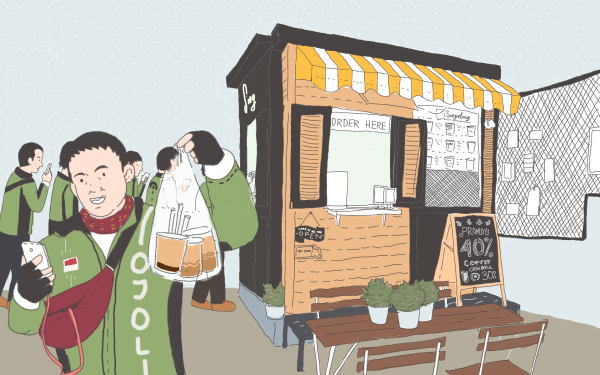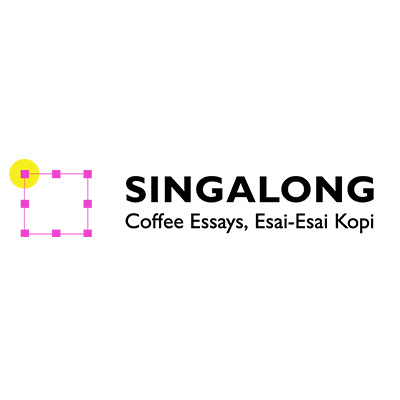Read in English Kalau pernah menonton serial TV Si Doel Anak Sekolahan, pasti kita bisa…
Es Kopi Susu: Powered by Apps

Drawings by Ben @komikkopi
A coffee stall in Jakarta is packed with young people eager to get their hands on the es kopi susu drink with gula aren and avocado juice at the bottom. Next to them, a queue of online drivers in uniform and helmet almost outpour into the street, their hands busy checking their orders on the phone.
The coffee stall itself is small, designed for to-go or delivery, and has very few seating. But the queue remains long throughout the day, alternating between passerby looking to quench their thirst, millennials aiming to get their hands on the latest es kopi susu brand, and online drivers picking up orders to be delivered across the city.
A cold drink as simple as es kopi susu might never go out of fashion. Even in the middle of third wave specialty coffee that revolves around origin, es kopi susu is trending higher than ever. And es kopi susu will only evolve over time, adapting its flavors to fit the market’s tastes. Back then, es kopi susu came in a small coffee sachet; now, es kopi susu competes in the market by utilizing one of the most accessible technologies in the digital era—online delivery apps.
A cold drink as simple as es kopi susu might never go out of fashion. Even in the middle of third wave specialty coffee that revolves around origin, es kopi susu is trending higher than ever.
Ever since the widespread use of online delivery apps, it seems that there is a new es kopi susu brand popping up almost every day. As an online food delivery apps, GoFood provides solution for es kopi susu sellers to market their products. According to VP Corporate Affairs Food & Merchant Gojek, Rosel Lavina, the amount of coffee ordered through Go Food reach 16 million orders in the last two years. In fact, coffee is one out of four food and beverages category ordered by 50% of new Go Food users throughout 2018, making it the fastest-growing demand, according to Kilas Balik Kuliner 2018 by GoFood.
Since 2015, GoFood stands as an online food delivery service and part of the super ecosystem by Gojek app. To date, GoFood has partnered with 400,000 partners merchants throughout Southeast Asia, and 96% of them are small to medium size businesses. That’s also what brought GoFood to be the leader in the online food delivery industry.
“According to our own internal data, the number of coffee orders throughout 2018 is equivalent to the amount of water needed to fill 80% of Olympic-size swimming pools,” Rosel continued. That’s 2,000,000 liter! Simple, easy to pack, and easy to carry, cold beverages like es kopi susu is equivalent to chilled, carbonated drinks of the 2000s.
The hype of es kopi susu itself is rather egalitarian. If we look at es kopi susu brands on online delivery platforms, not all of them come from big brands. MAU Kopi & Minuman in Jelambar, Jakarta Barat, owned by Indah Febryyani, is one of the coffee kiosks that make the most out of this new technology.
“Initially, we only wanted to do take-aways and deliveries. After two months introducing the brand, while actively making the most out of the promotion feature, we began to make money via deliveries. But these days, some customers prefer to just hang out at our shop,” Indah said, who claimed to get 40% of sales from online delivery apps.
Ten years ago, opening a business based on take-away and delivery was not as easy as it is today. Creating a delivery-based business means there are expenses for drivers and motorbike rents, which isn’t just expensive but also demands a well-organized logistics system — a problem that is easily solved by online applications, such as Gojek.
Now, opening a store based on online delivery is no longer impossible. Small businesses are no longer limited selling to neighbors, but those across the city as well without putting much effort. Not surprisingly, home-based businesses are jumping on the es kopi susu wagon.
Creating a delivery-based business means there are expenses for drivers and motorbike rents, which isn’t just expensive but also demands a well-organized logistics system — a problem that is easily solved by online applications, such as Gojek.
As for Indah, the convenience from online delivery apps means that she can compete in her own way, such as taking the unusual late-night hours.
“Frankly, our sales peak after 11pm. Our market is those who still want to drink coffee in the middle of the night, but too lazy to go out or most coffee shops are closed,” said Indah. “My staff works until late afternoon. Then my husband takes over until late at night, sometimes even until 3-4 in the morning. ”
Similar to Indah, Fenissa, co-owner of Eggspresso at Tanjung Duren, also use online delivery apps to target even more niche markets.
“When Eggpresso opened, our goal is to serve office staff, moms at social meeting (arisan), and students after school. With groups like these, usually they will have snacks, milk tea or coffee that are affordable,” explained Fenissa.
Registering her business on various online delivery platforms was the first thing that she did when she first opened her coffee kiosk. “Why do we prioritize online delivery? Because online drivers typically pick up group orders. For example, 7-10 cups or 3-5 cups which are good for our sales,” said Fenissa. “Jakarta is jammed more than ever, so online deliveries is on the top of the list for people in Jakarta to buy whatever they want. They just sit and wait for the product to arrive.”
“Why do we prioritize online delivery? Because online drivers typically pick up group orders. For example, 7-10 cups or 3-5 cups which are good for our sales,” said Fenissa.
Indeed, it is no longer questionable to shop online almost every day. As the access to sellers is shortened, demand increases. Bang Salim, a branding adviser from Jakarta, said that he and his office colleagues order es kopi susu online almost every other day. Just with a click, you have yourself a coffee break.
As market changes, so are the marketing strategies. Flyers and brochures are replaced with regular Instagram posts. Discount cards are ditched for questionnaires. Ads are replaced with boosts by online influencers. For Fenissa, getting the online marketing strategy right is number one priority.
“We always update our Instagram, work with different online delivery apps, traveloka eats, pergikuliner.com, zomato, and sign up to various cashless system because they usually have interesting cashback,” said Fenissa.
Ordering food or drinks through delivery is nothing new (remember McDonald’s phone number?). But just like Indah, Fenissa and other coffee kiosks owners see great opportunities now that it is easier than ever to do businesses based on delivery. With more opportunities, location is no longer a factor, hiring drivers and renting a motorbike is no longer needed and es kopi susu—a drink perfect for any time of the day—who wouldn’t love that?
By anindhea





